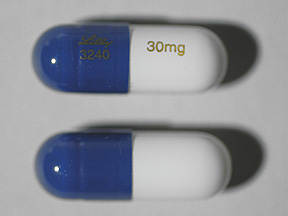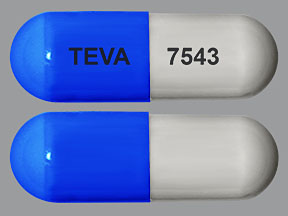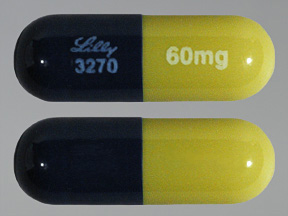Duloxetine
pronounced as (doo lox’ e teen)
Duloxetine is used to treat depression and anxiety. In addition, duloxetine is used to help relieve nerve pain (peripheral neuropathy) in people with diabetes or ongoing pain due to medical conditions such as arthritis, chronic back pain, or fibromyalgia (a condition that causes widespread pain).
Duloxetine may improve your mood, sleep, appetite, and energy level, and decrease nervousness. It can also decrease pain due to certain medical conditions. Duloxetine is known as a serotonin-norepinephrine reuptake inhibitor (SNRI). This medication works by helping to restore the balance of certain natural substances (serotonin and norepinephrine) in the brain.
OTHER USES: This section contains uses of this drug that are not listed in the approved professional labeling for the drug but that may be prescribed by yourhealth care professional. Use this drug for a condition that is listed in this section only if it has been so prescribed by your health care professional.
This medication may also be used to help treat other painful nerve conditions (neuropathic pain).
IMPORTANT WARNING:
A small number of children, teenagers, and young adults (up to 24 years of age) who took antidepressants (”mood elevators”) such as duloxetine during clinical studies became suicidal (thinking about harming or killing oneself or planning or trying to do so). Children, teenagers, and young adults who take antidepressants to treat depression or other mental illnesses may be more likely to become suicidal than children, teenagers, and young adults who do not take antidepressants to treat these conditions. However, experts are not sure about how great this risk is and how much it should be considered in deciding whether a child or teenager should take an antidepressant. Children younger than 18 years of age should not normally take duloxetine, but in some cases, a doctor may decide that duloxetine is the best medication to treat a child’s condition.
You should know that your mental health may change in unexpected ways when you take duloxetine or other antidepressants even if you are an adult over 24 years of age. These changes may occur even if you do not have a mental illness and you are taking duloxetine to treat a different type of condition. You may become suicidal, especially at the beginning of your treatment and any time that your dose is increased or decreased. You, your family, or caregiver should call your doctor right away if you experience any of the following symptoms: new or worsening depression; thinking about harming or killing yourself, or planning or trying to do so; extreme worry; agitation; panic attacks; difficulty falling asleep or staying asleep; aggressive or hostile behavior; irritability; acting without thinking; severe restlessness; frenzied abnormal excitement; or any other unusual changes in behavior. Be sure that your family or caregiver checks on you daily and knows which symptoms may be serious so they can call the doctor if you are unable to seek treatment on your own.
Your healthcare provider will want to see you often while you are taking duloxetine, especially at the beginning of your treatment. Be sure to keep all appointments for office visits with your doctor.
The doctor or pharmacist will give you the manufacturer’s patient information sheet (Medication Guide) when you begin treatment with duloxetine. Read the information carefully and ask your doctor or pharmacist if you have any questions. You also can obtain the Medication Guide from the FDA website: http://www.fda.gov/Drugs/DrugSafety/InformationbyDrugClass/UCM096273.
No matter your age, before you take an antidepressant, you, your parent, or your caregiver should talk to your doctor about the risks and benefits of treating your condition with an antidepressant or with other treatments. You should also talk about the risks and benefits of not treating your condition. You should know that having depression or another mental illness greatly increases the risk that you will become suicidal. This risk is higher if you or anyone in your family has or has ever had bipolar disorder (mood that changes from depressed to abnormally excited) or mania (frenzied, abnormally excited mood), depression, or has thought about or attempted suicide. Talk to your doctor about your condition, symptoms, and personal and family medical history. You and your doctor will decide what type of treatment is right for you.
Why is this medication prescribed?






Duloxetine is used to treat depression and generalized anxiety disorder (GAD; excessive worry and tension that disrupts daily life and lasts for 6 months or longer). Duloxetine is also used to treat pain and tingling caused by diabetic neuropathy (damage to nerves that can develop in people who have diabetes) and fibromyalgia (a long-lasting condition that may cause pain, muscle stiffness and tenderness, tiredness, and difficulty falling asleep or staying asleep). Duloxetine is also used to treat ongoing bone or muscle pain such as lower back pain or osteoarthritis (joint pain or stiffness that may worsen over time). Duloxetine is in a class of medications called selective serotonin and norepinephrine reuptake inhibitors (SNRIs). It works by increasing the amounts of serotonin and norepinephrine, natural substances in the brain that help maintain mental balance and stop the movement of pain signals in the brain.
How should this medicine be used?
Duloxetine comes as a delayed-release (releases the medication in the intestine to prevent break-down of the medication by stomach acids) capsule to take by mouth. When duloxetine is used to treat depression, it is usually taken once or twice a day with or without food. When duloxetine is used to treat generalized anxiety disorder, the pain of diabetic neuropathy, fibromyalgia, or ongoing bone or muscle pain, it is usually taken once a day with or without food. Take duloxetine at around the same time(s) every day. Follow the directions on your prescription label carefully, and ask your doctor or pharmacist to explain any part you do not understand. Take duloxetine exactly as directed. Do not take more or less of it, take it more often, or take it for a longer time than prescribed by your doctor.
Swallow the delayed-release capsules whole; do not split, chew, or crush them. Do not open the delayed-release capsules and mix the contents with liquids or sprinkle the contents on food.
Your doctor may start you on a low dose of medication and increase your dose after one week.
Duloxetine may help control your symptoms but will not cure your condition. It may take 1 to 4 weeks or longer before you feel the full benefit of duloxetine. Continue to take duloxetine even if you feel well. Do not stop taking duloxetine without talking to your doctor. Your doctor will probably decrease your dose gradually. If you suddenly stop taking duloxetine, you may experience withdrawal symptoms such as nausea; vomiting; diarrhea; anxiety; dizziness; tiredness; headache; pain, burning, numbness, or tingling in the hands or feet; irritability; difficulty falling asleep or staying asleep; sweating; and nightmares. Tell your doctor if you experience any of these symptoms when your dose of duloxetine is decreased.
Other uses for this medicine
Duloxetine is also sometimes used to treat stress urinary incontinence (leakage of urine during physical activity such as coughing, sneezing, laughing, and exercise) in women. Talk to your doctor about using this medication to treat your condition.
This medication may be prescribed for other uses; ask your doctor or pharmacist for more information.
What special precautions should I follow?
Before taking duloxetine,
- tell your doctor and pharmacist if you are allergic to duloxetine, any other medications, or any of the ingredients in duloxetine delayed-release capsules. Ask your doctor or pharmacist for a list of the ingredients.
- tell your doctor if you are taking thioridazine or a monoamine oxidase (MAO) inhibitor, such as isocarboxazid (Marplan), linezolid (Zyvox); methylene blue; phenelzine (Nardil), selegiline (Eldepryl, Emsam, Zelapar), and tranylcypromine (Parnate), or if you have stopped taking an MAO inhibitor within the past 14 days. Your doctor will probably tell you not to take duloxetine. If you stop taking duloxetine, you should wait at least 5 days before you start to take an MAO inhibitor.
- tell your doctor and pharmacist what other prescription and nonprescription medications and vitamins you are taking or plan to take. Be sure to mention any of the following: anticoagulants (‘blood thinners’) such as warfarin (Coumadin, Jantoven); antidepressants such as amitriptyline (Elavil), amoxapine (Asendin), clomipramine (Anafranil), desipramine (Norpramin), doxepin (Adapin, Sinequan), imipramine (Tofranil), nortriptyline (Aventyl, Pamelor), protriptyline (Vivactil), and trimipramine (Surmontil); antihistamines; aspirin and other nonsteroidal anti-inflammatory drugs (NSAIDs) such as ibuprofen (Advil, Motrin) and naproxen (Aleve, Naprosyn); buspirone; cimetidine (Tagamet); diuretics (‘water pills’); fentanyl (Abstral, Actiq, Fentora, Onsolis, others); medications for irregular heartbeat such as amiodarone (Cordarone), flecainide (Tambocor), moricizine (Ethmozine), propafenone (Rythmol), and quinidine (Quinidex); medications for anxiety, high blood pressure, mental illness, pain, and nausea; propranolol (Inderal); medications for migraine headaches such as almotriptan (Axert), eletriptan (Relpax), frovatriptan (Frova), naratriptan (Amerge), rizatriptan (Maxalt), sumatriptan (Imitrex), and zolmitriptan (Zomig); lithium (Eskalith, Lithobid); proton pump inhibitors such as lansoprazole (Prevacid), omeprazole (Prilosec), pantoprazole (Protonix), and rabeprazole (Aciphex); quinolone antibiotics such as ciprofloxacin (Cipro) and enoxacin (Penetrex); sedatives; certain selective serotonin reuptake inhibitors (SSRIs) such as fluoxetine (Prozac, Sarafem), fluvoxamine (Luvox) and paroxetine (Paxil); sibutramine (Meridia); sleeping pills; theophylline (Theochron, Theolair); tramadol (Ultram); and tranquilizers. Many other medications may interact with duloxetine, so be sure to tell your doctor about all the medications you are taking, even those that do not appear on this list. Your doctor may need to change the doses of your medications or monitor you carefully for side effects.
- tell your doctor what nutritional supplements and herbal products you are taking, especially products containing St. John’s wort or tryptophan.
- tell your doctor if you drink or have ever drunk large amounts of alcohol or if you use or have ever used street drugs or have ever overused prescription medications. Also tell your doctor if you have or have ever had a heart attack; high blood pressure; seizures; coronary artery disease (blockage or narrowing of the blood vessels that lead to the heart); or heart, liver, or kidney disease. If you have diabetes, be sure to talk to your doctor about how serious your condition is so your doctor can decide if duloxetine is right for you.
- tell your doctor if you are pregnant, especially if you are in the last few months of your pregnancy, or if you plan to become pregnant or are breast-feeding. If you become pregnant while taking duloxetine, call your doctor. Duloxetine may cause problems in newborns following delivery if it is taken during the last months of pregnancy.
- if you are having surgery, including dental surgery, tell the doctor or dentist that you are taking duloxetine.
- you should know that duloxetine may make you drowsy, dizzy, or may affect your judgment, thinking or coordination. Do not drive a car or operate machinery until you know how this medication affects you.
- ask your doctor about the safe use of alcoholic beverages while you are taking duloxetine. Alcohol can increase the risk of serious side effects from duloxetine.
- you should know that duloxetine may cause dizziness, lightheadedness, and fainting when you get up too quickly from a lying position. This is more common when you first start taking duloxetine or with an increase in dose. To avoid this problem, get out of bed slowly, resting your feet on the floor for a few minutes before standing up.
- you should know that duloxetine may cause high blood pressure. You should have your blood pressure checked before starting treatment and regularly while you are taking this medication.
- you should know that duloxetine may cause angle-closure glaucoma (a condition where the fluid is suddenly blocked and unable to flow out of the eye causing a quick, severe increase in eye pressure which may lead to a loss of vision). Talk to your doctor about having an eye examination before you start taking this medication. If you have nausea, eye pain, changes in vision, such as seeing colored rings around lights, and swelling or redness in or around the eye, call your doctor or get emergency medical treatment right away.
What special dietary instructions should I follow?
Unless your doctor tells you otherwise, continue your normal diet.
What should I do if I forget a dose?
Take the missed dose as soon as you remember it. However, if it is almost time for the next dose, skip the missed dose and continue your regular dosing schedule. Do not take a double dose to make up for a missed one.
What side effects can this medication cause?
Duloxetine may cause side effects. Tell your doctor if any of these symptoms are severe or do not go away:
- nausea
- vomiting
- constipation
- diarrhea
- heartburn
- stomach pain
- decreased appetite
- dry mouth
- increased urination
- difficulty urinating
- sweating or night sweats
- dizziness
- headache
- tiredness
- weakness
- drowsiness
- muscle pain or cramps
- changes in sexual desire or ability
- uncontrollable shaking of a part of the body
Some side effects can be serious. If you experience any of the following side effects, or those mentioned in the IMPORTANT WARNING or SPECIAL PRECAUTIONs section, call your doctor immediately or get emergency medical treatment:
- unusual bruising or bleeding
- pain in the upper right part of the stomach
- swelling of the abdomen
- itching
- yellowing of the skin or eyes
- dark colored urine
- loss of appetite
- extreme tiredness or weakness
- confusion
- flu-like symptoms
- fever, sweating, confusion, fast or irregular heartbeat, and severe muscle stiffness
- fever
- blisters or peeling skin
- rash
- hives
- difficulty breathing or swallowing
- swelling of the face, throat, tongue, lips, eyes, hands, feet, ankles, or lower legs
- hoarseness
Duloxetine may cause other side effects. Call your doctor if you have any unusual problems while taking this medication.
If you experience a serious side effect, you or your doctor may send a report to the Food and Drug Administration’s (FDA) MedWatch Adverse Event Reporting program online (http://www.fda.gov/Safety/MedWatch) or by phone (1-800-332-1088).
What should I know about storage and disposal of this medication?
Keep this medication in the container it came in, tightly closed, and out of reach of children. Store it at room temperature and away from excess heat and moisture (not in the bathroom). Throw away any medication that is outdated or no longer needed. Talk to your pharmacist about the proper disposal of your medication.
In case of emergency/overdose
In case of overdose, call your local poison control center at 1-800-222-1222. If the victim has collapsed or is not breathing, call local emergency services at 911.
Symptoms of overdose may include the following:
- agitation
- hallucinating (seeing things or hearing voices that do not exist)
- fast heartbeat
- fever
- loss of coordination
- nausea
- vomiting
- diarrhea
- drowsiness
- seizures
- dizziness
- lightheadedness
- fainting
- unresponsiveness
What other information should I know?
Keep all appointments with your doctor.
Do not let anyone else take your medication. Ask your pharmacist any questions you have about refilling your prescription.
It is important for you to keep a written list of all of the prescription and nonprescription (over-the-counter) medicines you are taking, as well as any products such as vitamins, minerals, or other dietary supplements. You should bring this list with you each time you visit a doctor or if you are admitted to a hospital. It is also important information to carry with you in case of emergencies.
Brand names
- Cymbalta®
Last Revised – 11/15/2014